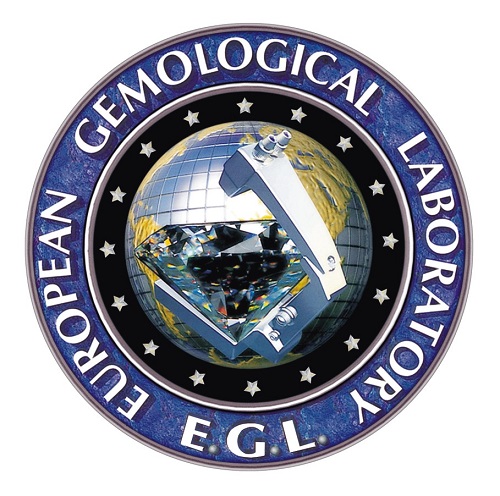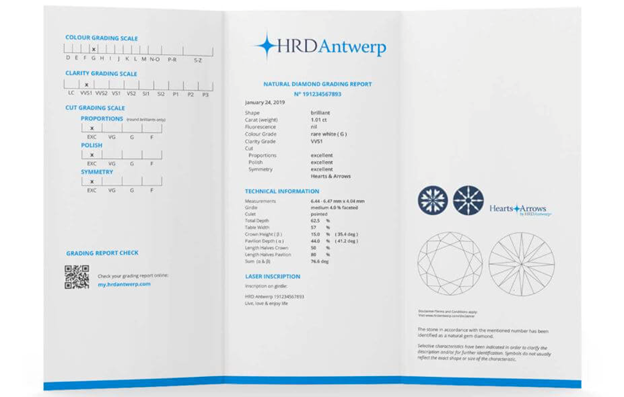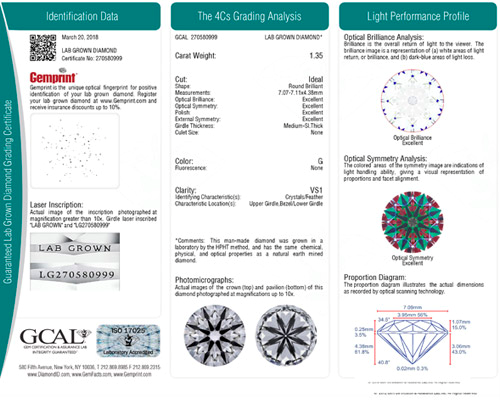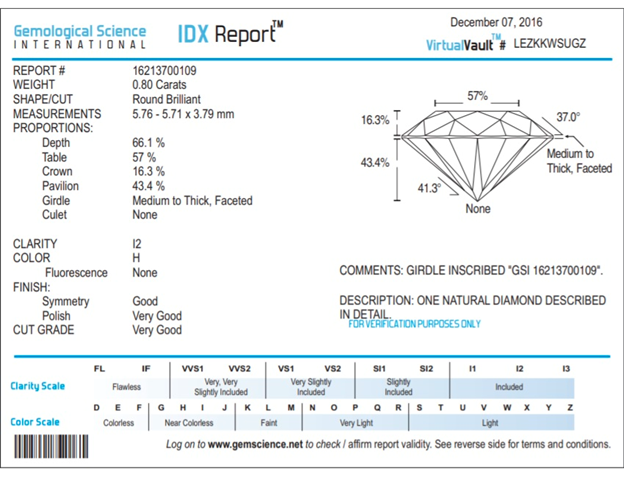When venturing into the world of diamonds, understanding the significance of diamond certification is paramount. These certifications, provided by reputable diamond certification bodies, are not just pieces of paper; they are your assurance of the diamond’s authenticity, quality, and integrity. In this guide, we will navigate the intricate landscape of diamond certification, spotlighting the main bodies that set the global standards for diamond evaluation.
The Gemological Institute of America (GIA), the American Gem Society (AGS), the European Gemological Laboratory (EGL), the International Gemological Institute (IGI), HRD Antwerp, Gem Certification & Assurance Lab (GCAL), and Gemological Science International (GSI) represent a spectrum of organizations within the diamond certification industry. Each body has its unique grading system, standards, and areas of specialization, offering detailed insights into a diamond’s characteristics, including its cut, color, clarity, and carat weight—the fundamental 4 Cs of diamond quality.
Understanding the nuances of each certification is crucial for any buyer, whether you’re investing in a timeless piece for personal enjoyment or selecting the perfect symbol of love and commitment. This guide aims to demystify the world of diamond certifications, providing you with the knowledge needed to make informed decisions and select a diamond that meets your exacting standards. Join us as we delve into the specifics of each major diamond certification body, exploring their methodologies, reputations, and the value they add to your diamond buying journey.
GIA – Gemological Institute of America

Founded in 1931, the GIA is the world’s leading authority on colored stone, diamonds and pearls. Widely respected across every continent the GIA were the first institute to create the 4 C’s and along with it the International Diamond Grading System™ – A standard which is still used today, nearly 80 years after its initial release.
Diamond Color
Diamonds are graded on their color from D – Z, with D being colorless and demanding a higher premium and Z being a more budget option and of a yellow or brown hue. Diamonds are viewed under strict lighting conditions and precise viewing conditions against other diamonds with a known color. Diamonds graded from D-R will have slight variations in color which may not be visible to the naked eye but the color grading has a massive impact on the overall quality and price of the diamond. Diamonds with a grading of S-Z may have color deformities which can be visible to the naked eye.
Diamond Clarity
GIA also takes into consideration the clarity of a diamond when grading it. There are 11 grading scales for the clarity of a diamond. Diamonds are viewed under 10x magnification, taking into consideration the size, nature, color, relief quantity and position of the clarity characteristics visible. The scale of clarity has become an international standard with every jeweler around the world using the GIA scale but it’s important to know what the grades actually mean.
- FL (Flawless) – No inclusions or visible blemishes under 10× magnification.
- IF (Internally Flawless) – No inclusions, however there may be small amounts of surface graining (barely visible under 10x magnification.)
- VVS1 (Very, Very Slightly Included 1) – Inclusions are extremely hard to see using 10× magnification.
- VVS2 (Very, Very Slightly Included 2) – Inclusions are difficult to see using 10× magnification.
- VS1 (Very Slightly Included 1) – Inclusions are tricky to see using 10× magnification.
- VS2 (Very Slightly Included 2) – Inclusions will not affect the beauty of a diamond and are only detected using 10× magnification.
- SI1 (Slightly Included 1) – Inclusions are noticeable using 10× magnification and some will be visible to the naked eye.
- SI2 (Slightly Included 2) – Inclusions are noticeable using 10× magnification and the most will be visible to the naked eye.
- I1, I2, and I3 (Included) – Inclusions are very obvious using 10× magnification and to the naked eye.
AGS/AGSL – American Gem Society Laboratories

The American Gem Society (AGS) and the Gemological Institute of America (GIA) are both esteemed institutions in the realm of diamond grading and certification. Although AGS Laboratories was recently incorporated into GIA, the legacy and impact of AGS certifications on diamond quality assessment remain significant, especially for those who already own AGS certified diamonds. Recognizing the unparalleled precision in cut grading by AGS, GIA now offers an AGS Ideal Report for the finest diamonds, a service that vendors like Whiteflash, known for specializing in top-tier diamonds, provide to their customers.
Established in 1996, AGS quickly became a frontrunner in the diamond industry by introducing a revolutionary grading system focused on diamond cut quality. This innovation marked the beginning of a new era in consumer expectations for diamond cuts. AGS and GIA, while now more closely integrated, have historically served complementary roles in the industry: GIA has set benchmarks for color and clarity, whereas AGS carved out a niche with its cut grading based on proportions and its scientifically derived performance cut grade. Introduced in 2005, this cutting-edge system employs detailed physical measurements and advanced computer analysis, offering a more nuanced assessment than its predecessors.
AGS Diamond Cut Grading
Renowned for setting the standard with its Ideal Cut Grade for Round Brilliant diamonds, known affectionately as the “AGS Triple Zero Cut” or “AGS Ideal,” AGS has played a pivotal role in elevating cut quality. The AGS grading scale, ranging from 1 to 10 with 1 representing the pinnacle of cut quality, demonstrates the laboratory’s commitment to excellence. Unique among grading systems, the AGS methodology extends beyond the classic round brilliant to encompass other shapes such as oval, princess, and cushion cuts. This versatility ensures that various diamond shapes can achieve optimal brilliance and fire under the rigorous standards of AGS grading.
An AGS report offers comprehensive details about the diamond, including its cut, symmetry, shape, dimensions, carat weight, and profile, culminating in a final grade. Diamonds that meet AGS’s stringent criteria for cut quality are accompanied by an AGS Platinum Diamond Report, tracing their journey from grading to consumer possession. While AGS considers all Four Cs in its evaluations, its cut certification stands out for its objective approach, minimizing the subjective bias often associated with grading color and clarity.
European Gemological Laboratories (EGL)

Over time, the European Gemological Laboratories (EGL) has faced significant scrutiny concerning its diamond grading practices, and rightfully so. Despite boasting numerous achievements, EGL has struggled to establish a globally recognized standard for assessing diamond cut, clarity, and color. Industry professionals often express skepticism towards EGL certificates due to a history of inconsistencies in diamond quality assessments, with instances of diamonds being over-graded by three to four levels.
One of the core issues with EGL is its decentralized structure, comprising various independently operated entities such as EGL Los Angeles, EGL New York, EGL Europe, and EGL Israel. This fragmentation has led to a lack of uniform grading standards and, consequently, diminished credibility in their reports. When compared to the more consistent and rigorous evaluations by the Gemological Institute of America (GIA) and the American Gem Society (AGS), EGL certifications significantly lag, affecting the market value of EGL-graded diamonds.
Despite these diamonds sometimes appearing identical to their GIA or AGS-graded counterparts to the untrained eye, detailed and systematic testing reveals substantial discrepancies. These variations not only impact the diamond’s price but also highlight the importance of opting for stones certified by more reputable organizations like AGS and GIA, which assure accuracy and reliability.
Informed decision-making is key in the diamond purchase process. As consumers grow more knowledgeable, they are increasingly opting for online shopping to avoid potentially misleading advice from retailers. The backlash against EGL’s grading inconsistencies has led to significant actions, including lawsuits against the EGL and the exclusion of EGL Diamond Reports by Rapnet, underscoring the critical need for transparency and trust in diamond certification.
To safeguard your investment, we recommend selecting diamonds certified by AGS and GIA, the gold standards in the industry. By doing so, you ensure not just the quality of your diamond, but also the integrity of its assessment.
IGI – International Gemological Institute

International Gemological Institute is a diamond, jewelry, and colored stone certification organization. IGI was established in 1975 and since its inception, has offices in several diamond centers around the world. Increasingly trying to position itself as a reliable diamond grading laboratory, they have over 650 gemologists and other jewelry professionals at their disposal.
They have found themselves as a leader in lab-grown diamonds due to their stringent grading. IGI has examined and certified millions of pieces of jewelry, diamonds, and colored stones across the globe. Additionally, they offer appraisal services, educational courses and workshops to customers around the world.
In addition to providing certification for diamonds, IGI also offers assurance in other areas such as appraisals and identification of precious metals & gemstones. They make sure that you get a fair market value based on the latest trends and demands of consumers. This makes them one of the most reliable certifications in the industry as they strive to meet international standards of excellence.
HRD Antwerp Certification
HRD Antwerp, the abbreviation for Hoge Raad voor Diamant (Diamond High Council), is situated in the heart of Antwerp, Belgium, a city with a rich history in diamond trade. Established in 1973, HRD Antwerp has positioned itself as a notable entity in diamond certification, especially within Europe. It is recognized for its detailed analysis of a diamond’s characteristics, such as Cut, Color, Clarity, and Carat Weight, through its certification process.

However, it’s important for consumers to be aware that HRD Antwerp has faced criticism for its grading standards, which some experts argue may be more lenient compared to other leading certification bodies. This perceived leniency can sometimes result in diamond grades that appear inflated when compared to the assessments given by institutions like the GIA or AGS. Such discrepancies have sparked debates on the reliability and consistency of HRD Antwerp’s grading system.
Despite these concerns, HRD Antwerp maintains a commitment to quality, education, and innovation in gemology. Their laboratories are equipped with advanced technology, and their gemologists are known for their expertise. Nonetheless, when considering a diamond certified by HRD Antwerp, it’s advisable for shoppers to conduct thorough research and possibly seek comparisons with diamonds certified by other leading laboratories.
For those navigating the diamond market, understanding the nuances between different certification bodies is crucial. While HRD Antwerp provides valuable services and contributions to the industry, potential buyers should approach with an informed perspective, ensuring that their choice aligns with their expectations for quality and value.
GCAL (Gem Certification & Assurance Lab)
GCAL (Gem Certification & Assurance Lab) stands as a pillar of trust and excellence in the diamond certification world. Distinguished for its precision, integrity, and innovation, GCAL offers a comprehensive suite of services that goes beyond the traditional 4Cs (Cut, Color, Clarity, Carat Weight) to include detailed gemstone analysis and assurance guarantees. Founded on the principle of providing accurate, reliable, and transparent diamond grading, GCAL has earned its place as a well-respected authority in the industry.

What sets GCAL apart is its commitment to consumer confidence and satisfaction. Each diamond certified by GCAL is backed by a Zero Tolerance Consumer Grading Guarantee, ensuring that the quality and characteristics of the diamond meet the strict standards set forth in the report. Furthermore, GCAL’s certificates include a unique Gemprint®—an optical fingerprint of each diamond—which serves as an additional layer of security and identification, a feature that is particularly valued in the high-stakes world of diamond trading.
GCAL’s state-of-the-art laboratory employs cutting-edge technology and methodologies to assess and grade diamonds. The lab’s gemologists are highly skilled professionals, dedicated to upholding the highest levels of accuracy and ethics. This dedication to excellence is evident in their detailed reports, which provide not only the standard grading information but also insights into a diamond’s optical brilliance, fire, and scintillation.
For consumers seeking assurance and peace of mind in their diamond purchases, GCAL represents a trustworthy choice. The lab’s rigorous standards, innovative features, and comprehensive reporting make it a standout option for those who value quality and transparency. Whether for engagement rings, investment pieces, or personal treasures, choosing a GCAL-certified diamond means opting for one of the most reliable and respected assurances available in today’s market.
The Gemological Science International (GSI)
Gemological Science International (GSI) is one of the newer players in the realm of diamond certification, having established itself as a key service provider to large retail jewelry chains. Positioned as a global entity with a wide reach, GSI aims to offer quick and reliable diamond grading services. However, it’s crucial for consumers to approach GSI certifications with a well-informed perspective, especially considering the concerns raised about the objectivity and reliability of their grading processes.

Critics argue that GSI faces a potential conflict of interest, as the financial incentives tied to certifying large volumes of diamonds for retail chains may impact the strictness of their grading standards. This situation can lead to diamonds being awarded inflated grades, which, while beneficial for the retail price point, may not accurately reflect the true quality of the diamond. Such practices can challenge the integrity of diamond certification, making it harder for consumers to make informed decisions based on these reports.
Despite these concerns, GSI contributes to the industry by offering services like laser inscription and educational resources, which are valuable tools for both retailers and consumers. They utilize advanced technology and methodologies in their grading process, aiming to provide detailed and accurate assessments of diamonds.
For consumers considering a GSI-certified diamond, it is advisable to complement the GSI report with additional research or even seek a second opinion from other reputable certification bodies. Educating oneself about the nuances of diamond grading and the reputation of certifying labs is essential in navigating the complex diamond market confidently and making purchases that align with one’s values and expectations.
Final Thoughts on Diamond Certification
Navigating the world of diamond certification is essential for making informed decisions about your precious investments. The Gemological Institute of America (GIA), the American Gem Society (AGS), the European Gemological Laboratory (EGL), the International Gemological Institute (IGI), HRD Antwerp, Gem Certification & Assurance Lab (GCAL), and Gemological Science International (GSI) each play distinct roles in the certification landscape. Among these, GIA stands out as the premier choice for certifying natural diamonds, offering unmatched reliability and accuracy. The option to obtain an additional AGS Ideal report through GIA further cements its position as the gold standard for those seeking the pinnacle of diamond quality and craftsmanship.
For lab-created diamonds, the IGI presents a reputable option, recognized for its specialized focus and expertise in this growing segment of the market. GCAL, with its commitment to transparency and consumer assurance, also deserves mention for those prioritizing detailed analysis and security features in their diamond certification.
When it comes to selecting where to purchase these treasures, Whiteflash shines as the leading retailer for the finest diamonds, offering a stellar selection of GIA and AGS-certified stones. For those exploring sustainable and ethically sourced options, Brilliant Earth provides a compelling choice with its dedication to environmental and social responsibility. Meanwhile, James Allen and Blue Nile offer a range of choices that cater to varying budgets and preferences, making them suitable options for those seeking quality at more accessible price points.

Richard Jenkins, The Diamond Guru
Get free assistance from the Diamond Guru today. You’ll be glad you did!
- Secure the best quality diamond for your budget.
- Don’t pay over the odds for your diamond ring.
- Have peace of mind that you didn’t get ripped off.
Have a Question? Contact us now…



